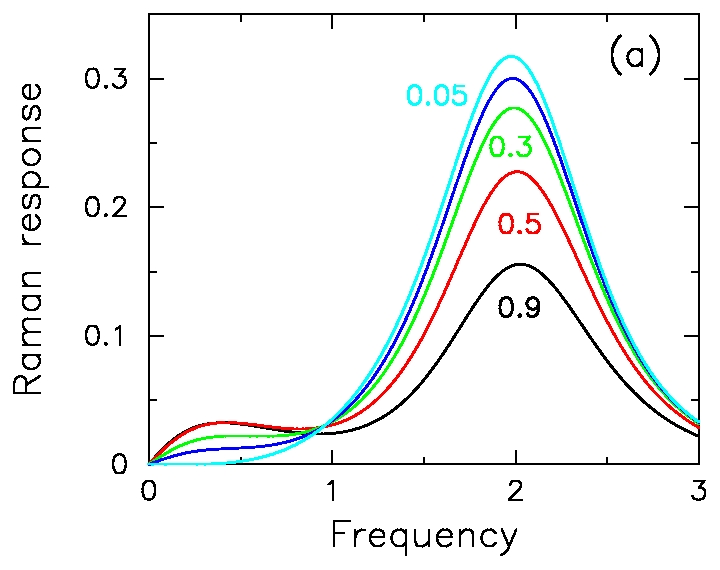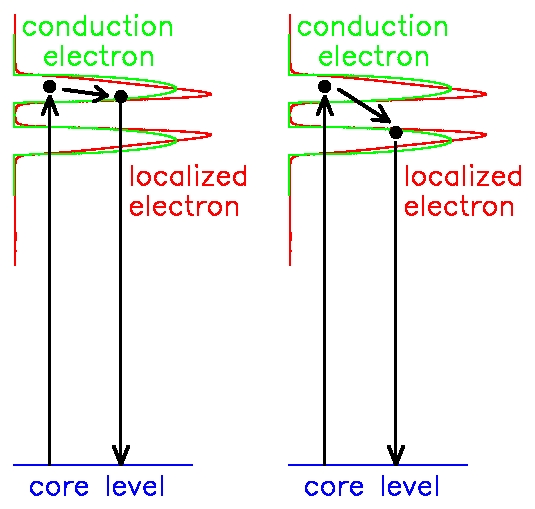Inelastic light scattering
In this project, we are examining how light interacts with strongly correlated
materials. Our focus is on inelastic light scattering, where the light changes
color after interacting with the charge excitations of the material. Recently,
there has been significant focus on inelastic x-ray scattering, where the
photon is sensitive to structures on the nanoscale. There is very little
theory for how such interactions take place when the material is
strongly correlated. We examine both nonresonant scattering, where the
response function depends only on the change of color of the photon
(not its original color) and resonant scattering, where it depends on both
the color and the change in color of the photon. Recently, we have discovered
an interesting new sum rule for inelastic light scattering, which relates to
the potential energy of the many-body system, much like the optical conductivity
sum rule relates to the kinetic energy of the strongly correlated system.
Annotated list of publications
Raman scattering

- A. M. Shvaika, O. Vorobyov,
J. K. Freericks,
and T. P. Devereaux,
Electronic Raman scattering in correlated materials: A treatment of
nonresonant, mixed, and resonant scattering with dynamical mean field theory
Materials, Phys. Rev. B 71, 045120--1-17 (2005).
- A. M. Shvaika, O. Vorobyov,
J. K. Freericks,
and T. P. Devereaux,
Resonant Enhancement of Inelastic Light Scattering in Strongly Correlated
Materials, Phys. Rev. Lett. 93, 137402--1-4 (2004).
A. M. Shvaika, O. Vorobyov,
J. K. Freericks,
and T. P. Devereaux,
Resonant Enhancement of Electronic Raman Scattering,
(proceedings of the Spectroscopy in Novel Systems conference
in Barcelona Spain, 2004) J. Phys. Chem. Solids 67, 336--339 (2006).
- A. M. Shvaika, O. Vorobyov,
J. K. Freericks,
and T. P. Devereaux,
Resonant electronic Raman scattering near a quantum critical point,
(proceedings of the Strongly Correlated Electron
Systems conference, Karlsruhe, Germany), Physica B 359--361C,
705--707 (2005).
- J. K. Freericks,
T. P. Devereaux,
R. Bulla,
and
Th. Pruschke,
Nonresonant inelastic light scattering in the Hubbard model,
Phys. Rev. B 67, 155102--1-8 (2003).
This is the first work to calculate a Raman response for a system that
undergoes a metal-insulator transition. We find that our results are universal
on the insulating side of the metal-insulator transition and display the three
fundamental features seen in experiment on strongly correlated materials:
(i) a rapid loss of low-energy spectral weight and a gain of high-energy
spectral weight as temperature is lowered; (ii) the appearance of an
isosbestic point, where the Raman response is independent of temperature at a
characteristic frequency; and (iii) the ratio of the range in frequency over
which the Raman response is depleted at low temperature to the onset
temperature where the depletion begins is large. This behavior has been seen
SmB6, FeSi, and the high-temperature superconductors. The extension
of the nonresonant work to the resonant case represents one of the most
complex solutions to a many-body problem with DMFT. We founmd three interesting
results in the resonant regime as well: (i) the isosbestic behavior is now
easily seen in all channels; (ii) there is a double resonance occuring
when the transfered energy approaches the incident photon energy;
and (iii) there is a joint resonance of the low-energy peak and the
charge-transfer peak when the photon energy is on the order of U.
Inelastic x-ray scattering

- T. P. Devereaux,
G. E. D. McCormack and
J. K. Freericks,
Inelastic x-ray scattering as a probe of electronic correlations,
Phys. Rev. B 68, 075105--1-11 (2003).
- T. P. Devereaux,
G. E. D. McCormack and
J. K. Freericks,
Inelastic x-ray scattering in correlated (Mott) insulators,
Phys. Rev. Lett. 90, 067402--1-4 (2003).
The first series of papers examine the nonresonant inelastic X-ray
scattering, which can resemble the resonant response (to a zeroth-order
approximation). We find a number of interesting features of the response:
(i) isosbestic behavior is seen in all symmetry channels for all
transfered wavevectors; (ii) the nonresonant response is independent of
the symmetry channel when we are at the Brillouin zone corner indicating
that any polarization dependence there is a direct measure of nonlocal
fluctuations; and (iii) the low-energy peak disperses, while the charge-transfer
peak broadens through the Brillouin zone. Current work is focusing on
examining resonant effects.
Sum rules for inelastic light scattering
- J.K. Freericks
and T.P. Devereaux,
Sum rules for inelastic scattering in the Hubbard model,
Physica B 378--380, 650--653 (2006)
(Proceedings of the Strongly Correlated
Electrons Systems 2005 conference, Vienna, Austria, July, 2005).
- J.K. Freericks,
T.P. Devereaux,
M. Moraghebi, and
S.L. Cooper,
Optical sum rules that relate to the potential energy of
strongly correlated systems, Phys. Rev. Lett. 94,
216401--1-4 (2005).
In this work, we discover a new set of optical sum rules that are valid
for inelastic light scattering, and which relate to the potential energy
(rather than the kinetic energy as in the optical sum rule). These sum rules
are shown to hold for SmB6 and should hold for a wide range
of strongly correlated materials. The sum rules do suffer from some difficulty
with being able to separate the low-energy band from higher bands, but
appear for both the Falicov-Kimball model and the Hubbard model.
Last modified September 12, 2004.
Jim Freericks, Professor of Physics

